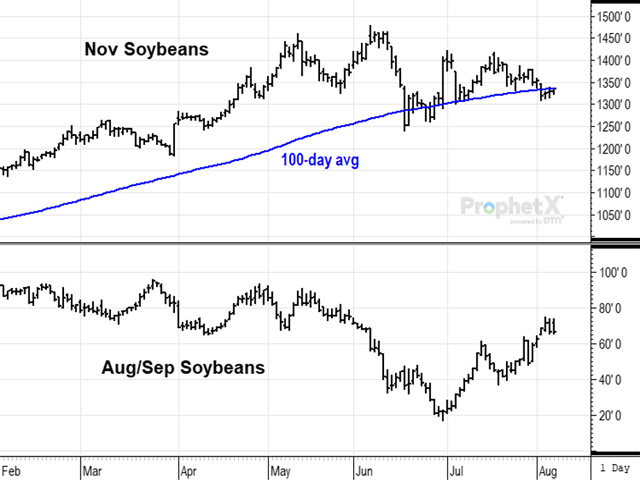Todd's Take
A Phony Break in Soybean Prices?
On Tuesday, Aug. 3, I was invited by Linder Farm Network to briefly talk markets at a friendly gathering at Farmfest 2021 near Redwood Falls, Minnesota. At the top of the conversation, I announced that December corn was trading down 7 cents and soybeans were down 35 cents. As you can imagine, the news was as welcome as a skunk at a garden party.
Not only were soybeans down sharply, they actually closed below the 100-day average for only the third time since June 2020. From a seasonal perspective, this technical break in the uptrend was about a month late, but still in line with the usual tendency for soybean prices to head lower toward harvest.
Keep in mind, the western Minnesota audience I was speaking to are trying to raise corn and soybean crops in very difficult conditions in 2021. Some have not had a good rain since planting time, and before that, you have to go back to the summer of 2020. It was surprising to me but crops in the region looked good enough that a couple of beneficial rains in August could still do wonders. Talking to producers, however, the stress was obvious.
At DTN, we advocate looking at markets from several perspectives and Tuesday's technical break is a good example of why it is important to also have a fundamental context in addition to what we see on the charts. From a fundamental view, U.S. soybean supplies remain historically tight.
Granted, cash soybean prices are down roughly $3 from their May peak, but Thursday's DTN National Soybean Index of $13.51 per bushel is still among the highest prices seen since 2014. August soybeans, just one week away from expiration, are priced over 60 cents above the September contract and have yet to encounter a delivery -- a bullish indication of how strong commercial demand is for the current soybean market.
P[L1] D[0x0] M[300x250] OOP[F] ADUNIT[] T[]
Here in early August, traders are fixated on weather and trying to estimate the size of this year's soybean crop. It is well known by now that soybean crop conditions are severely stressed in the Dakotas and could suffer some loss in Minnesota and Iowa but are in generally good shape everywhere else.
In all the hubbub over this year's yields, we shouldn't forget USDA's estimate that only 87.6 million acres of soybeans were planted. Even if harvested acres held steady and soybeans matched their all-time national record of 52.0 bushels per acre, we're only talking about a 4.50-billion-bushel crop -- not enough to build much, if any surplus in 2021-22.
Part of Tuesday's selling may have been related to growing concerns about the COVID-19 delta variant. Confirmed cases of the variant are on the rise in several parts of the world, including the U.S., several Asian countries and in China, where last year's pandemic began.
The threat to soybean and other grain prices is not so much that people will stop eating, but that commerce will become so difficult again, causing the flow of grain could be interrupted. Theoretically, we can't rule out the possibility of another economic logjam, but so far market clues favor the anticipation of another year of strong demand for U.S. soybeans.
The most bullish piece of recent evidence comes from Brazil where FOB soybean prices for September have become more expensive relative to the U.S. Thursday's closes showed the gap at 47 cents per bushel in favor of U.S. soybeans at the Gulf, enough to overcome Brazil's advantage in shipping costs and still look good to Chinese importers.
The bottom line is, similar to a year ago, China has purchased Brazilian soybeans so aggressively that they will soon be turning to the U.S. for more new-crop soybeans. Even after buying much of Brazil's record soybean crop, September soybean prices on China's Dalian exchange show no sign of breaking down and are priced at the equivalent of $18.29 per bushel.
Uncertainty is always a factor when we try to look ahead and surprises do occur. Here in early August, weighing all the important factors for soybeans that we currently know, it is difficult to put much stock in Tuesday's technical sell-off, and I expect soybean prices to show better consideration for demand once we get more settled about harvest.
As I mentioned, life has its share of surprises. Driving west from Farmfest on Thursday afternoon, I encountered a good soaking rain; I had almost forgotten how good rain smelled.
**
Comments above are for educational purposes only and are not meant as specific trade recommendations. The buying and selling of grain or grain futures or options involve substantial risk and are not suitable for everyone.
Todd Hultman can be reached at Todd.Hultman@dtn.com
Follow him on Twitter @ToddHultman1
(c) Copyright 2021 DTN, LLC. All rights reserved.



